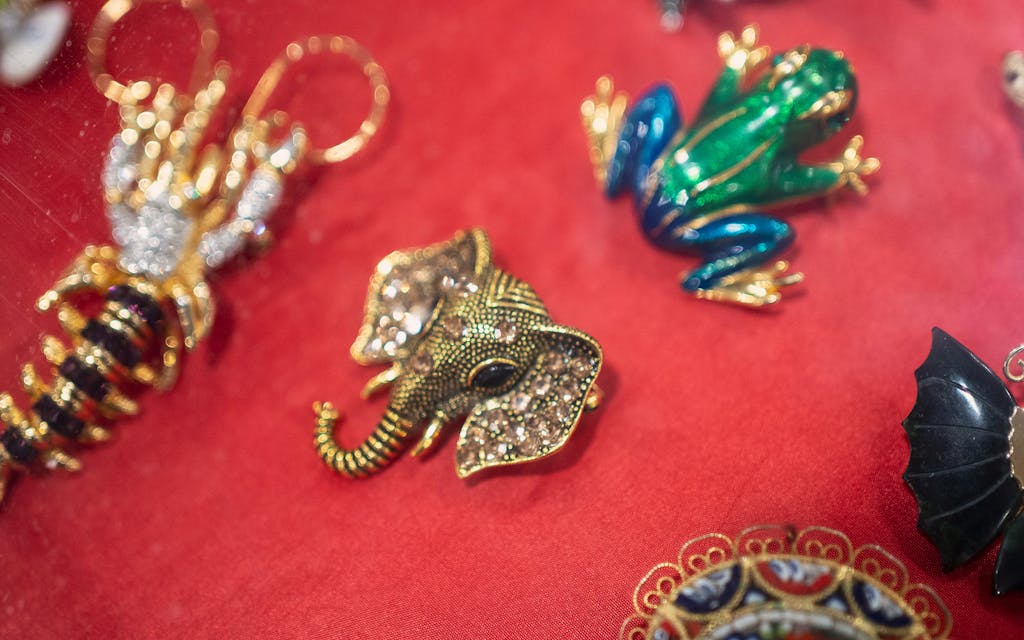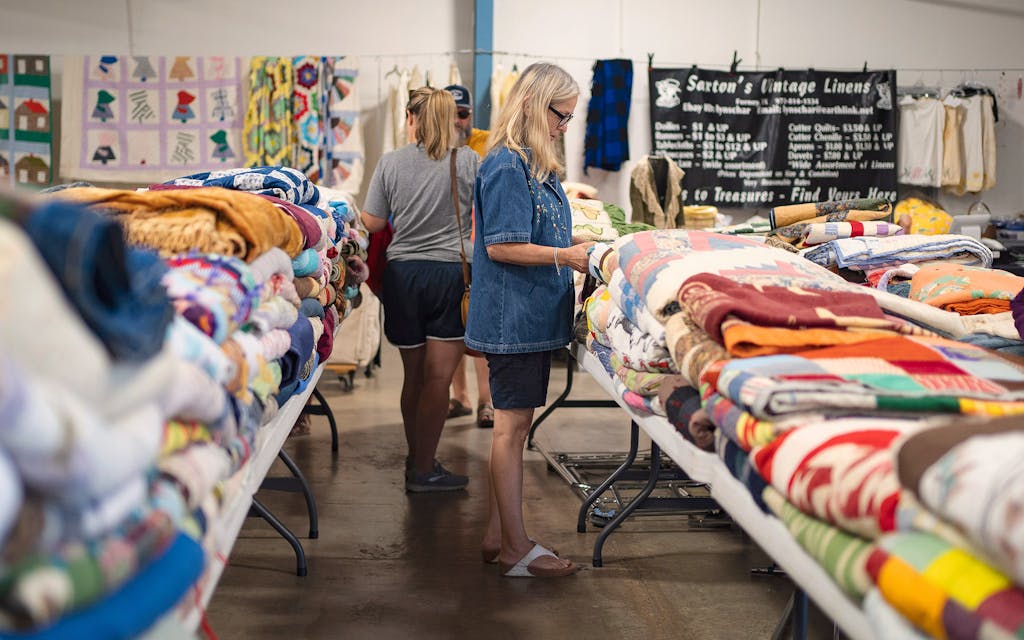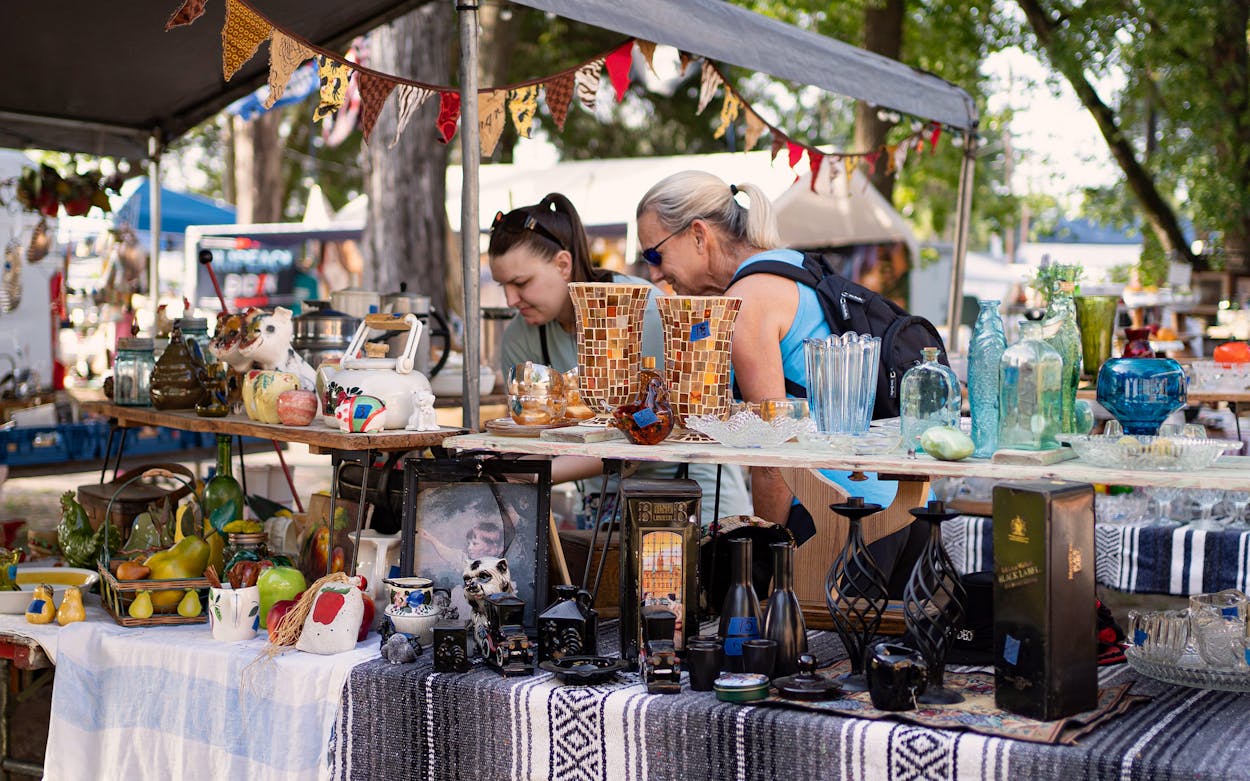Featured in the Dallas City Guide
Discover the best things to eat, drink, and do in Dallas with our expertly curated city guides. Explore the Dallas City Guide
The town of Canton doesn’t show up right away when you call up a map of Texas online. Zoom in on the Dallas–Fort Worth area, though, and the hidden gem, about an hour southeast of Dallas on Interstate 20, finally appears.
It normally has a population of less than 4,000, but for four days every month, Canton swells up to about 100,000 when people flock to what’s billed as the largest flea market in the world, spanning four hundred acres. The market’s roots go back to the 1850s, when the circuit-court judge came to Canton to hold court on the first Monday of the month, attracting residents from around the region who would come to sell livestock and other goods. It evolved into what is now called First Monday Trade Days, although the epic shopping event is no longer on a Monday; rather, it runs from the Thursday to Sunday before the first Monday of the month.
Any other time during the month, Canton looks like just another Texas-interstate outpost, with a historic square and a conveniently located gas station. But I want to see and experience the town in its full glory, so I’ve decided to spend 24 hours at First Monday Trade Days. As I remove my kids’ car seats to make room for future purchases, my husband gives me a knowing smile.
“Don’t come back with too much crap,” he says.
But he doesn’t realize that for more than 160 years, the city has banked on the thinking that one man’s trash is another’s treasured memory.


5 p.m. Saturday
If I ever meet Saint Peter, I’d like to think he would be standing on a porch that looks like the entrance to the Buffalo Girls Hotel. It’s flanked by the American flag on one side and the Texas flag on the other. Words on the top wooden step boast of treats inside the general store, which doubles as the hotel office: “Salsas and Dips.” “Candy and Coffee.” “Jams and Jellies.” The two signs posted on the stair railing, though, are what seal the deal.
“Pecan Pie in A Jar.” Just below it: “Mountain Brownies with Scoop of Blue Bell Ice Cream SOLD HERE.”
Cowboy Mike, the man at the check-in counter, tells me there’s a “great lineup” of music over at the nearby Mathis Family Store tonight. I have been craving a cold drink on a patio, so this sounds ideal. Just follow the boardwalk, he tells me.
The Buffalo Girls, owned by Susan Matassa, is part of the Mountain, a Western-themed labyrinth of shops and motels on a hill less than a mile from the town square—think Swiss Family Robinson meets campground. There are staged gunfights several times a day under the canopy of post oak trees. On Saturday nights, places stay open until at least 10 p.m.
After I get settled, I drive to the Canton courthouse and the restaurants that surround it in the square. I’m not surprised to find several have a wait, so I cross the street and order the Fire Cracker Burger (bacon, jalapeños, pepper jack, and chipotle sauce) at the counter of JT2, a family “ranch-to-table” establishment that’s also a meat market. Afterward, I walk around the square and imagine how it looked when First Monday was held here. Before I let my mind wander too far to the public hangings in early years, I decide it’s time to enjoy some live music.
When I return to the Mountain, I walk toward the sound of someone tuning a guitar, which leads me to a shack with a tin roof. It has an extended side porch that serves as a stage facing an empty lot. The only stools are the two onstage, and there’s no bar. I ask one of the women by the front door where I can buy a beer. “It’s BYOB,” she says, and points. “There’s a gas station down the street.”

7:45 p.m. Saturday
Once I have a can in hand, I pick one of the dozen plastic chairs spread across the patch of dirt. The show was pegged to begin nearly 45 minutes ago, but I’m just one of a handful in the audience. I wonder if I misheard or am in the wrong spot. It feels like I stumbled into someone else’s backyard.
Behind me, the sun dips below the horizon. A tall yellow “1st Monday Parking” sign across the street flickers on as it preps for another night of advertising. The roar of cicadas causes me to look up. I can now see that blue Christmas lights have been strung in a checkered pattern from the porch to a post on the other side of the lot. My eyes are drawn back to the stage when Koby Allen, a Texas country artist who recently released his first single, opens his set with a rasp that reminds me of Gary Allan. In the low light of dusk, the place has been transformed. Its rough edges have been softened, and it’s taken on an ethereal glow.
While Allen performs, I chat with Colton Mathis, who bought the “store” with his wife Shelby in the last week of February 2020—just a few weeks before the pandemic shutdown.
Mathis, who is from Crandall and is a musician himself, bought a fiddle at the market early last year and walked around the Mountain for the first time just to see what it was about. A woman saw his instrument and mentioned that this location was for sale. He walked on the porch with his wife and could see its potential.
“I just had this feeling,” he recalls. “I turned around and told her, ‘I don’t know how much it is, but if we can buy it, I want this place.’ Because I could feel it.”
9 p.m. Saturday
Tired and hoping for a good night’s sleep before tackling the market, I head back to Buffalo Girls. My room is next door to the store in a duplex-style cabin with a wide front porch. Beveled Texas stars adorn the camel-colored walls. Stars are also embroidered on the quilts that cover the two double beds, and even more are etched into the lamps. One photo of a longhorn stares at me from the far wall as I drift off.


7 a.m. Sunday
The market runs from dawn to dusk, but it’s quiet when I arrive around sunrise. A few people look like they just woke up as they emerge slowly out of RVs. Armed with a large cup of joe from the farmhouse-style Southern Brew Coffee that I picked up on the way, I wander around unattended booths in the famous vendor fields—acres of canopied storefronts with vintage and handmade goods—and get an early peek at the wares. A rotary phone. A book called The Sensuous Woman. A fat pencil from the 1984 Republican National Convention.
As I pass by a yellow school bus with a Chili’s “Like No Place Else” sign on the side, Weeks Crawford greets me. His shop is set up in the middle of the vendor fields, although he hasn’t always had such a prominent location. He started out eight years ago with two booths a few hundred feet up a hill next to the bathrooms. “We’d holler at them,” he says of the would-be customers on their way back from relieving themselves. “We kept seeing people down here. We kept saying, ‘One day we’re going to get down there.’”
Crawford eventually made it to the center of the fields. Over the years, his family scooped up adjoining spots as they became available, like a game of Monopoly. Now they have twelve booths stocked with small items such as knickknacks, high-end glassware, and brass tableware. His bread and butter is furniture he builds with wood taken from nineteenth-century barns. Today, there are a few benches left. His top-selling kitchen islands were gone by Friday morning. But his biggest moneymakers aren’t displayed on a table. He also sells real estate, he tells me. He must think my confused look is because of the overalls he’s wearing, or the school bus where he and his wife sleep when in town, because he laughs and says, “We’re not as poor as we look.”
But it’s not appearances that have me stumped. Is the sale of real estate even allowed at First Monday Trade Days? (As long as he’s not distributing pornographic material, selling live animals, or reading palms, anything is fair game.) Does he own all of these properties? (Yes. That’s usually where the old wood comes from.) How do potential buyers know he has land for sale? (He just talks to them until it comes up and then he shows them a binder with photos.)
Today he has a fifty-acre ranch available. He’s already set up three viewings for next week.
“If they buy something here, that’s good,” he says, referring to the wares at his booth. “And if they buy a three-quarters of a million dollars property up there, that’s pretty good too.”

10 a.m. Sunday
Deby Grubbs had never been to a garage sale before she met her husband, Bobby. Decades later, the couple from Waxahachie operates a large booth in the Civic Center, an air-conditioned building for antiques and other delicate items. “He grew up in a junking family,” she says. “This gives him an opportunity to buy his junk and sell it.”
It’s not that Grubbs thinks of their stuff as trash. She just knows there are more valuable things at the market. She’s already cried once this morning about what won’t be here next month.
Catty-corner to her table, Charlene Corbell’s glass case is a little emptier than it was earlier this weekend. Her jewelry stock won’t be replenished.
At 88, Corbell has decided to pack up and retire. For the second time. She left her job as a secretary at Exxon when she was 71. She knew she liked jewelry, so she set up a booth to sell a few pieces of her own. Over the years, she picked up an eye for appraisal and acquired pieces from other dealers. It’s never been about the money, though. She was born into a society that was reeling from the Great Depression. When she was a kid, everything from sugar to shoes was rationed to support the war effort. She’s okay having just enough.
Being a vendor in Canton isn’t about getting rich, Corbell says. It’s a social experience.
“None of us make much money in here, but it gets to be like family,” she says. “When you see somebody every month for sixteen years, you get to love them.”
11:15 a.m. Sunday
I decide to get lunch back in the square at the Kickin Mule, which has American fare. It used to be home to a fourteen-foot salad bar, but the pandemic put a pause on that. I go the other direction with a chicken-fried steak, and, since I’m already in deep, I round it out with a root beer and chocolate-chip banana-bread pudding for dessert.
When I reach into my bag for my credit card, my hand brushes jagged edges of a crystal that belongs to my four-year-old daughter, Helen. Right before I left for the trip, she ran up to her room to get the amethyst. As it is for most small kids and crystals, it’s a prized possession of hers. She handed it over and told me, “When you miss me, you can look at it.”
I think of her as back at the market, where I see a baby in a stroller reach out and touch a metal rooster as his mom talks with a shop owner.
The crowds have picked up, and so have the lines to booths selling lemonade. Some shoppers are on motorized scooters or are pulling wagons filled with goods. Although I’m having to weave in and out of the crowds, it’s still not as busy as I’m told it will be in cooler months. I look down and see a piece of trash on the ground: a red paper heart with “ty” on the front. I guess it doesn’t matter much anymore, but the millennial in me cringes as I realize that someone bought a Beanie Baby today and ripped its tag off.

1:20 p.m. Sunday
The mercury hits 92 degrees as I walk in and out of open-air metal buildings. The humidity makes it feel like 102. Similar to when a flame melts a wax candle, the heat amplifies the smells around me: the sweetness of funnel cake at a food truck and smokiness of leather from a saddle shop. I walk into a store with Christmas decorations. The pine aroma is at odds with the sweltering sun.
A booth near antique row is full of painted wooden birdhouses. I pick a blue and silver one.
“Cowboy colors, huh?” the man selling it comments. I mutter, “Oh, that’s not going to work,” and find one in red and blue. A backyard tribute to the Oilers’ Warren Moon and the only football team my family has ever loved.
The heat is becoming too much, so I head back inside the Civic Center to cool off.
In the corner of the building, there are at least ten tables with quilts piled high. I make a beeline for them. I’m sure everyone has something they look for their entire life. For me, it’s the kind of Chianti I had with my husband on our honeymoon in Rome—I scan the shelves every time I’m in a wine store. My mom’s elusive search is for a quilt that her aunt made for her and her sister more than forty years ago. It’s a simple pattern. Hand-sewn brown strips form a tic-tac-toe, and tulips pop up in each box. My mom’s was misplaced around the time her aunt passed in 2006. She’s tried for years to find a replacement or have a new one commissioned, but the cost estimates have been astronomical.
Since I’m here, I start a search party for her and dive into the piles in front of me.
4:40 p.m. Sunday
It starts to sprinkle on my windshield as I pull my car out of the gravel lot. My skin is tight from the heat despite repeated applications of sunscreen. I feel a blister forming on my right foot. But I’m happy with my steals. Three vinyl records: George Strait, REO Speedwagon, and Otis Redding’s Live in Europe. A vintage Tinkertoy construction set for my kids.
My last purchase was back at Crawford’s spot. I hurried as some were folding up their canopies and worried that it wouldn’t be there anymore. I had seen it first thing that morning and discounted it as too dirty. But the thought of it tugged at me throughout the day. When I told Crawford what it meant to me, he shoved the $10 back into my hand and refused to take money for it.
As I join the line of cars heading toward I-20, I reach over and touch it. It has a yellow tint and some rips. But the tulips are hand-stitched. The pattern is eerily similar to that of the missing quilt. After seeing the photo of it that I texted to her, my mom is certain she can clean it up. I know when she looks at it, she’ll think of her Aunt Helen. Maybe she’ll think of me too.






